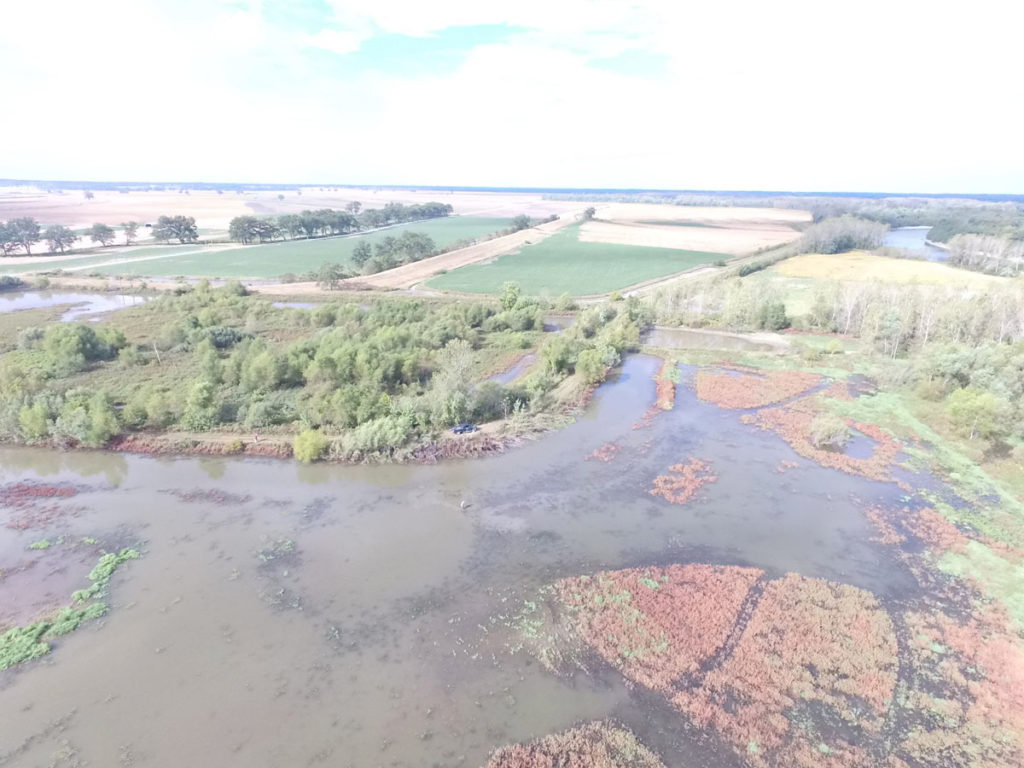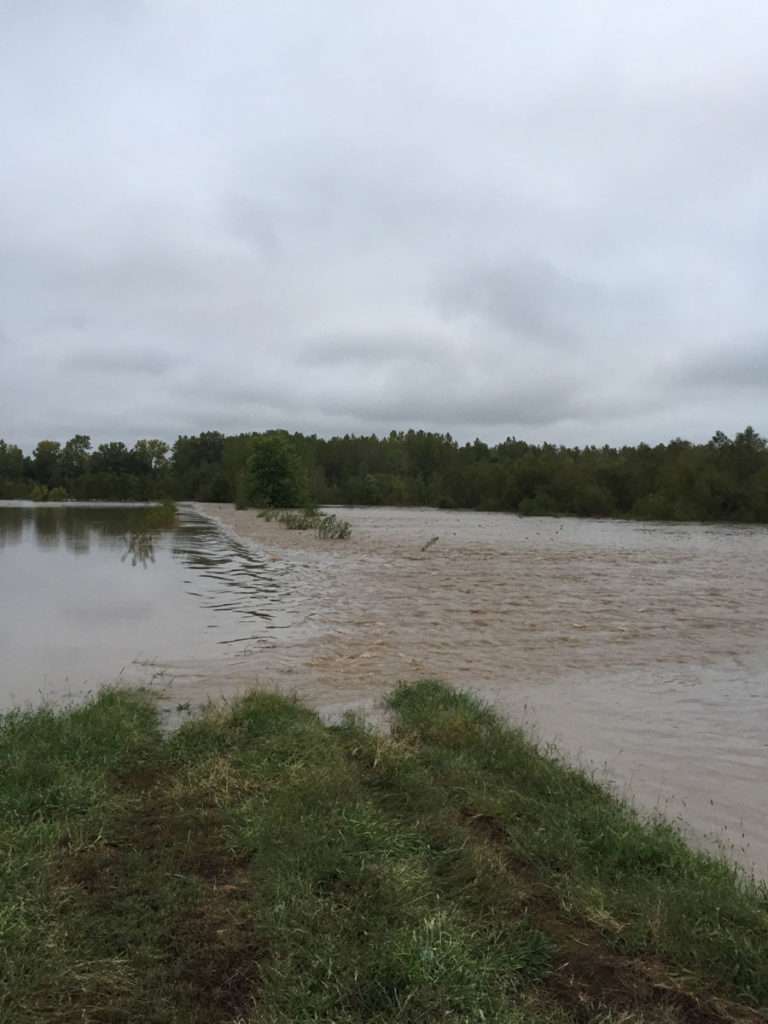It seems so far off, that first day of the season. Reality though is those of us fully engaged with the management of a wetland need to start getting ready. I know you field hunters might not care so much, but this article might help you understand all that goes into being prepared.

Your early spring marsh should be holding water and will become a perfect resting and feeding stopover on the spring migration north.
Spring
As I write this just after the vernal equinox, Mother Nature has provided flooding across much of Nebraska, Iowa, South Dakota, and Missouri. In fact, the wetland I help with is 10 feet under water. Therefore, the lesson here is you never know what Mother Nature will throw at us, and you never know how a lot of hard work might be lost at any time.

If you are lucky, spring flooding can renew your wetland with moisture, but too much water can make a mess.
I speak here not of perennial wetlands, but rather the ones we cycle on-and-off each year. While commonly designated as wetland reserve, these may not function as wetlands all year long. Spring though is a unique time. Ducks and geese are migrating back to their breeding grounds and passing through typically the same environments they witnessed on the fall migration south. For the most part, April 1 is the date of drawdown on these designated wetlands, but you can draw down on private lands anytime you want. Keep in mind though, migrating ducks need nourishment and the wet spring marsh is now full of small fish, snails, leeches, water fleas, crayfish, and mayflies providing a very much needed source of protein for the breeding season ahead. You always have the option of keeping the pool full all year.

For area, water will remain most of the year if water tables are high. Do not put any effort into pumping this water out.
Pay attention to the drawdown and do it slowly. Also, note the surrounding areas that may become nesting grounds. Spring also gets us thinking about the crop we will plant or the retention of moist-soil environments. If you are lucky enough to be your own planter, timing is not as critical, otherwise, your neighboring farmer will plant it when they get their own planting complete. Disking may be required or weed control spray application to prepare the soil for planting. Mowing needs to be accomplished, but that should wait until the marsh is dry and free of any nesting species, usually around May 1 to September 15. Burning is an option too along with haying of the grasses that occur.

In some years, mowing is easy and in others, larger equipment might be necessary and some plants can grow ten feet tall.
Summer
If you are lucky enough to get your crop in during the normal growth to harvest cycle that is good. Keep in mind if planting corn, beans, or millet; a late planting may be fine since harvest may not be the outcome of planting but rather a crop to hunt overall season. By now, mowing is even more necessary, but while the marsh is dry, you might as well get to work on that blind. Move, rebuild, expand, are perfect blind projects all summer long. Access is so much easier in the summer. Hot yes, but lots of things to prepare. Repair a broken well and distribution pipes, roadways, downed trees, and remove beaver dams that may have blocked your waterway.

Summer is your opportunity to reset blinds, rebuild them and make any improvement that will be appreciated by all in the middle of the season.
Time as well to strip the old blind off all cover and prepare it for concealment in early fall. Pumping most likely will begin by mid-august to have water in place for the early teal season. This also provides a check of your work and preparation for pumping you have worked on during the summer. If you did get a crop planted you will have to mow lanes now before you flood.
It might be getting late, but dirt work has to be done and creating any new water areas late in the summer may force your hand to plant a late-season cover like Japanese millet. Otherwise, the marsh may be open for that first year with some moist soil growth not disturbed.

While you can and if you can get that equipment in to reduce high spots, level areas and remove obstructions.
Fall
Fall starts early and by now, you know what has survived and what your crop looks like going into the winter. I hope that no major flooding buried your crop and hard work. Many rules to follow on baiting, so make sure all mowing and clearing of crops occur at least 30 days before hunting. Cut those lanes and shooting areas well before the season starts. May even need one more mowing. Better to make sure the pump works now than when the season starts.

Each year cutting lanes change based on the last year’s observations. Birds have to have a place to land. Prevailing wind may dictate these cuts.
Begin the process of brushing in blinds and cutting all the willows and other brush before the first frost. This we know allows the leaves to remain all season. I am always amazed at how much we use. Mix in some oak branches for texture and be sure you cover the roof of the blind with something to keep it from leaking.
Install the ice eater and wiring for use later in the year. More than one is handy and can be used to muddy up the water even before ice is present. Boats and decoys need to be loaded and hauled to your wetland along with all blind interior comfort items.
Winter
The season is upon us so it time to hunt and hunt hard. Not a lot done other than monitoring the water levels and hunting. The marsh is locking up and having an ice eater really helps to open water after a couple of warm sunny days. Running your pump helps too with warmer water keeping the marsh open. If you were smart with your water management, you can gradually raise the level as the season goes along. This might afford you water that is more open. As the season comes to a close that frozen ground comes in handy. Easy after the season to get in and cut a few trees, get everything out of the blind, all equipment moved to high ground, drain the water distribution line and allow the pump to dry out. Keep the boards in the drains until later in the spring.
Winter also begins the thinking process for the next year. What worked, what did not, and changes you propose. Lots of conversation in the blind all season that now becomes even more important. It never fails that plans are disrupted by weather, schedules, and work. Getting items off the checklist early means fewer problems the next fall.
The life cycle of your marsh is important to waterfowl. Being conscious of providing habitat after the season and into the summer months will pay dividends the next season. It pays to be attentive and visit your marsh once a month or so. You learn what is using the area, how the water is interacting, and your mind begins to wander into the next great waterfowl season.









